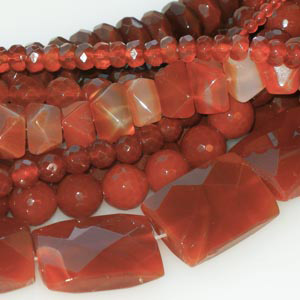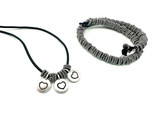Gemstone Index: Carnelian

Carnelian is an A-grade agate. What a lot of people call "true carnelian" is the fiery red/orange color, and in theory, carnelian is naturally that color. However, most of that fiery red/orange "true" carnelian is heat-treated in secret before it reaches the gemstone-cutting factory. This apparently has been a secret for thousands of years; each part of the world thought everyone else's carnelian was naturally red, but they were heating theirs, too. When held against the light, the color-treated carnelian shows its color in stripes, while natural carnelian shows a cloudy distribution of color. The name carnelian is said to be derived from the Latin word carnis ("flesh") due to its color.
Ancient Egyptian tombs are full of carnelian jewelry, as the Egyptians believed the gemstone had great power in the afterlife. According to their beliefs, carnelian amulets could help ensure the Ka's (soul's) passage into the next world. Elsewhere in the Middle East, carnelian represents the Hebrew tribe of Reuben and the apostle Philip. In Hebrew literature, carnelian appears as a gemstone in Aaron's breastplate. Some Muslims call it "the Mecca stone." Islamic doctrine holds that engraving the name of Allah on carnelian stones boosts courage. Ancient Greeks and Romans called it sardius and used the gemstone for signet rings, cameos and intaglios, while Tibetans created amulets of silver with generous applications of carnelian. Hindu astrology names carnelian as the secondary stone of Scorpios.
Carnelian is one of the alternate birthstones for July, and is popular for both first chakra and second chakra jewelry and amulets. Red carnelian has been used for centuries to stop the flow of blood, and many believe the gemstone will stop nosebleeds. It is said to help heal physical wounds and blood disorders, and bring passion to the wearer. It is recommended for infertility or impotency, and because of its ability to balance, carnelian is good for family areas of the home (especially a bedroom where more than one child sleeps). Deposits of this gemstone are found in Brazil, India, Australia, Russia, Madagascar, South Africa, Uruguay and the U.S.A.
Our Bead Blog
-
Simply Springy 2-Hole Bracelet
Apr 28th 2025Designed by: Guest Designer Deb Floros Suggested Supplies 1 #61-840-50-01 Beadalon Cord, WildFire,
-
Exotic Statement Necklace
Apr 28th 2025Designed by: Guest Designer Deb Floros Suggested Supplies 1 #88-400-003-5 58x50mm Pewter Connector,
-
Rubber Tubing Necklace and Memory Wire Bracelet Set
Mar 21st 2025Designed by: Guest Designer Deb Floros Suggested Supplies 1 #61-622-02 2mm Rubber Cord, Bulk, for J




